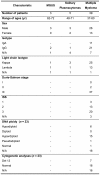Prognostic impact of cancer/testis antigen expression in advanced stage multiple myeloma patients
- PMID: 18237105
- PMCID: PMC2935785
Prognostic impact of cancer/testis antigen expression in advanced stage multiple myeloma patients
Abstract
This study aims to analyze the expression of 14 cancer/testis (CT) antigens in multiple myeloma (MM) to identify possible prognostic markers and therapeutic targets. The expression of MAGEA1, MAGEA2, MAGEA3/6, MAGEA4, MAGEA10, MAGEA12, BAGE1, MAGEC1/CT7, the GAGE family, LAGE-1, PRAME, NY-ESO-1, SPA17 and SSX1 was studied by RT-PCR in 15 normal tissues, a pool of 10 normal bone marrow samples, 3 normal tonsils and bone marrow aspirates from 6 normal donors, 3 monoclonal gammopathies of undetermined significance (MGUS), 5 solitary plasmacytomas, 39 MM samples (95% advanced stage) and the MM cell line U266. MAGEC1/CT7 was expressed in bone marrow aspirates from one MGUS and one plasmacytoma. The frequencies at which CT antigen were found to be expressed in MM patients were MAGEC1/CT7 77%, LAGE-1 49%, MAGEA3/6 41%, MAGEA2 36%, GAGE family 33%, NY-ESO-1 33%, BAGE-1 28%, MAGEA1 26%, PRAME 23%, SSX-1 26%, MAGEA12 20.5%, MAGEA4 0%, and MAGEA10 0%. Cox's regression model showed that GAGE family expression and having >6 CT antigens expressed were independent prognostic factors when all patients were analyzed. However, MAGEC1/CT7 expression was the only independent prognostic factor when non-transplanted patients where analyzed. Based on our findings, MAGEC1/CT7, MAGEA3/6 and LAGE-1 are good candidates for immunotherapy, since together they cover 85% of our MM cases. Furthermore, expression of the GAGE family, >6 CT antigens and MAGEC1/CT7 seem to have impact on MM prognosis.
Figures







Similar articles
-
Cancer-testis antigen expression in synovial sarcoma: NY-ESO-1, PRAME, MAGEA4, and MAGEA1.Hum Pathol. 2017 Mar;61:130-139. doi: 10.1016/j.humpath.2016.12.006. Epub 2016 Dec 16. Hum Pathol. 2017. PMID: 27993576
-
Cancer-testis (CT) antigen expression in medulloblastoma.Cancer Immun. 2008 Apr 22;8:7. Cancer Immun. 2008. PMID: 18426187 Free PMC article.
-
Is there any relationship between gene expression of tumor antigens and CD4+ T cells in multiple myeloma?Immunotherapy. 2014;6(5):569-75. doi: 10.2217/imt.14.24. Immunotherapy. 2014. PMID: 24896625 Clinical Trial.
-
Cancer-testis antigens: promising targets for antigen directed antineoplastic immunotherapy.Expert Opin Biol Ther. 2002 Aug;2(6):577-84. doi: 10.1517/14712598.2.6.577. Expert Opin Biol Ther. 2002. PMID: 12171503 Review.
-
Immunological and functional aspects of MAGEA3 cancer/testis antigen.Adv Protein Chem Struct Biol. 2021;125:121-147. doi: 10.1016/bs.apcsb.2020.08.001. Epub 2020 Oct 1. Adv Protein Chem Struct Biol. 2021. PMID: 33931137 Review.
Cited by
-
Cancer-testis antigen expression and immunogenicity in AL amyloidosis.Blood Cancer J. 2012 Sep 14;2(9):e90. doi: 10.1038/bcj.2012.32. Blood Cancer J. 2012. PMID: 22983433 Free PMC article.
-
Integrative analysis of DNA copy number, DNA methylation and gene expression in multiple myeloma reveals alterations related to relapse.Oncotarget. 2016 Dec 6;7(49):80664-80679. doi: 10.18632/oncotarget.13025. Oncotarget. 2016. PMID: 27811368 Free PMC article.
-
The cancer/testis antigen prostate-associated gene 4 (PAGE4) is a highly intrinsically disordered protein.J Biol Chem. 2011 Apr 22;286(16):13985-94. doi: 10.1074/jbc.M110.210765. Epub 2011 Feb 25. J Biol Chem. 2011. PMID: 21357425 Free PMC article.
-
SEMG1/2 augment energy metabolism of tumor cells.Cell Death Dis. 2020 Dec 11;11(12):1047. doi: 10.1038/s41419-020-03251-w. Cell Death Dis. 2020. PMID: 33311447 Free PMC article.
-
Expression and immune responses to MAGE antigens predict survival in epithelial ovarian cancer.PLoS One. 2014 Aug 7;9(8):e104099. doi: 10.1371/journal.pone.0104099. eCollection 2014. PLoS One. 2014. PMID: 25101620 Free PMC article.
References
-
- Kyle RA, Rajkumar SV. Multiple myeloma. N Engl J Med. 2004;351:1860–1873. - PubMed
-
- Barlogie B. High-dose therapy and innovative approaches to retreatment of multiple myeloma. Semin Hematol. 2001;38 (2 Suppl 3):21–27. - PubMed
-
- Orlowski RZ. Initial therapy of multiple myeloma patients who are not candidates for stem cell transplantation. Hematology Am Soc Hematol Educ Program. 2006:338–347. - PubMed
-
- Huff CA, Karp JE. Should MAGE be the rage in myeloma? [comment] Blood. 2005;106:5. [Comment on Jungbluth AA, Ely S, DiLiberto M, Niesvizky R, Williamson B, Frosina D, Chen YT, Bhardwaj N, Chen-Kiang S, Old LJ, Cho HJ. In: Blood 2005; 106: 167-174]
-
- Dadabayev AR, Wang Z, Zhang Y, Zhang J, Robinson WR, Lim SH. Cancer immunotherapy targeting SPA17: when should the laboratory findings be translated to the clinics? Am J Hematol. 2005;80:6–11. - PubMed
Publication types
MeSH terms
Substances
LinkOut - more resources
Full Text Sources
Other Literature Sources
Medical
Research Materials
